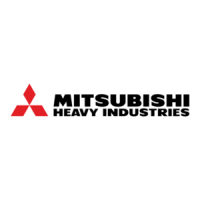
Do you have a question about the Mitsubishi Heavy Industries TU85SAE and is the answer not in the manual?
| Brand | Mitsubishi Heavy Industries |
|---|---|
| Model | TU85SAE |
| Category | Refrigerator |
| Language | English |
Switching between engine and motor drive based on power connection.
Selecting automatic start/stop or continuous operation modes.
Protecting evaporator from frosting during cooling operation.
Reducing operation sound by slowing engine speed.
Setting start and stop times for automatic operation.
Diagnosing the unit for potential troubles (Pre Trip Inspection).
Diagram showing the layout of key components.
Details and diagrams of the evaporator unit.
Details and diagrams of the condensing unit.
Details and diagrams of the cabin controller.
Description of the digital display and its icons.
Details of digital display elements and function icons.
Indicators for warnings and errors.
Indicators for current operation status.
Description of safety features and protective mechanisms.
Explanation of safety symbols and their meanings.
General safety guidelines and warnings.
Key safety warnings and actions to avoid.
Safety measures during and after operation.
Safety precautions for maintenance tasks.
Safety guidelines for loading cargo.
Safety precautions for electrical components.
Preventing accidental startups during maintenance.
Recommended attire for safe operation.
Precautions for handling lubricants and fluids.
Actions for detected abnormal conditions.
Procedures for emergency situations.
Guidelines for managing warning labels on the unit.
Overview of different display modes and their functions.
Flowchart for navigating user settings.
Procedure to set the current time and date.
Procedure to set the defrost interval.
Viewing operation time and cycles.
Procedure for forced fuel circulation.
Steps to turn on the refrigeration unit.
Operating with engine or motor.
Choosing between automatic and continuous operation.
General steps for starting the unit.
Procedure for normal shutdown.
Adjusting the desired temperature.
Operating at reduced noise levels.
Initiating defrost cycle manually.
Setting a scheduled start time.
Setting a scheduled stop time.
Performing pre-trip inspection diagnosis.
Steps before loading cargo into the container.
Procedures for loading and unloading cargo.
Procedure for unloading cargo from the container.
Safety measures before performing inspections.
Steps to open the front panel for inspection.
Steps to close the front panel securely.
Routine checks performed daily.
Checking the level of cooling water.
Checking belts and moving parts for wear.
Checking and refilling engine oil.
Checking fuel level and refueling.
Checking for leaks and wiring damage.
Cleaning the condenser coil for dust.
Scheduled maintenance checks.
Checklist for periodic maintenance.
Specifications for fluids and coolants.
Operating at low temperatures for extended periods.
Procedures for extended shutdowns.
Understanding alarm codes and warnings.
Actions to resolve detected troubles.
Procedure for replacing blown fuses.
Information to provide to the dealer.
Steps to restart after an emergency stop.
Troubleshooting guide for error codes.
